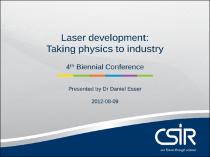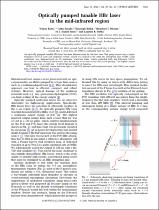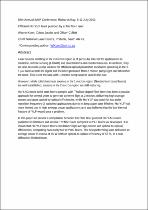 ResearchSpace
ResearchSpace
Comparative study of the dissociative ionization of 1,1,1-trichloroethane using nanosecond and femtosecond laser pulses
JavaScript is disabled for your browser. Some features of this site may not work without it.
- ResearchSpace
- →
- Research Publications/Outputs
- →
- Journal Articles
- →
- View Item
| dc.contributor.author |
Du Plessis, A

|
|
| dc.contributor.author |
Strydom, C

|
|
| dc.contributor.author |
Botha, L

|
|
| dc.date.accessioned | 2010-09-15T11:31:42Z | |
| dc.date.available | 2010-09-15T11:31:42Z | |
| dc.date.issued | 2010-03 | |
| dc.identifier.citation | Du Plessis, A, Strydom, C and Botha, L. 2010. Comparative study of the dissociative ionization of 1,1,1-trichloroethane using nanosecond and femtosecond laser pulses. International Journal of Molecular Science, Vol. 11(3), pp 1114-1140 | en |
| dc.identifier.issn | 1422-0067 | |
| dc.identifier.uri | www.mdpi.com/journal/ijms | |
| dc.identifier.uri | http://hdl.handle.net/10204/4361 | |
| dc.description | Copyright: 2010 MDPI, Open Access Journal | en |
| dc.description.abstract | Changes in the laser induced molecular dissociation of 1,1,1-trichloroethane (TCE) were studied using a range of intensities and standard laser wavelengths with nanosecond and femtosecond pulse durations. TCE contains C-H, C-C and C-Cl bonds and selective bond breakage of one or more of these bonds is of scientific interest. Using laser ionization time of flight mass spectrometry, it was found that considerable variation of fragment ion peak heights as well as changes in relative peak ratios is possible by varying the laser intensity (by attenuation), wavelength and pulse duration using standard laser sources. The nanosecond laser dissociation seems to occur via C-Cl bond breakage, with significant fragmentation and only a few large mass ion peaks observed. In contrast, femtosecond laser dissociative ionization results in many large mass ion peaks. Evidence is found for various competing dissociation and ionization pathways. Variation of the nanosecond laser intensity does not change the fragmentation pattern, while at high femtosecond intensities large changes are observed in relative ion peak sizes. The total ionization yield and fragmentation ratios are presented for a range of wavelengths and intensities, and compared to the changes observed due to a linear chirp variation. | en |
| dc.language.iso | en | en |
| dc.publisher | MDPI | en |
| dc.subject | Laser ionization | en |
| dc.subject | Laser dissociation | en |
| dc.subject | Coherent control | en |
| dc.subject | Ttrichloroethane | en |
| dc.subject | Molecular science | en |
| dc.subject | Nanosecond laser pulses | en |
| dc.subject | Femtosecond laser pulses | en |
| dc.title | Comparative study of the dissociative ionization of 1,1,1-trichloroethane using nanosecond and femtosecond laser pulses | en |
| dc.type | Article | en |
| dc.identifier.apacitation | Du Plessis, A., Strydom, C., & Botha, L. (2010). Comparative study of the dissociative ionization of 1,1,1-trichloroethane using nanosecond and femtosecond laser pulses. http://hdl.handle.net/10204/4361 | en_ZA |
| dc.identifier.chicagocitation | Du Plessis, A, C Strydom, and L Botha "Comparative study of the dissociative ionization of 1,1,1-trichloroethane using nanosecond and femtosecond laser pulses." (2010) http://hdl.handle.net/10204/4361 | en_ZA |
| dc.identifier.vancouvercitation | Du Plessis A, Strydom C, Botha L. Comparative study of the dissociative ionization of 1,1,1-trichloroethane using nanosecond and femtosecond laser pulses. 2010; http://hdl.handle.net/10204/4361. | en_ZA |
| dc.identifier.ris | TY - Article AU - Du Plessis, A AU - Strydom, C AU - Botha, L AB - Changes in the laser induced molecular dissociation of 1,1,1-trichloroethane (TCE) were studied using a range of intensities and standard laser wavelengths with nanosecond and femtosecond pulse durations. TCE contains C-H, C-C and C-Cl bonds and selective bond breakage of one or more of these bonds is of scientific interest. Using laser ionization time of flight mass spectrometry, it was found that considerable variation of fragment ion peak heights as well as changes in relative peak ratios is possible by varying the laser intensity (by attenuation), wavelength and pulse duration using standard laser sources. The nanosecond laser dissociation seems to occur via C-Cl bond breakage, with significant fragmentation and only a few large mass ion peaks observed. In contrast, femtosecond laser dissociative ionization results in many large mass ion peaks. Evidence is found for various competing dissociation and ionization pathways. Variation of the nanosecond laser intensity does not change the fragmentation pattern, while at high femtosecond intensities large changes are observed in relative ion peak sizes. The total ionization yield and fragmentation ratios are presented for a range of wavelengths and intensities, and compared to the changes observed due to a linear chirp variation. DA - 2010-03 DB - ResearchSpace DP - CSIR KW - Laser ionization KW - Laser dissociation KW - Coherent control KW - Ttrichloroethane KW - Molecular science KW - Nanosecond laser pulses KW - Femtosecond laser pulses LK - https://researchspace.csir.co.za PY - 2010 SM - 1422-0067 T1 - Comparative study of the dissociative ionization of 1,1,1-trichloroethane using nanosecond and femtosecond laser pulses TI - Comparative study of the dissociative ionization of 1,1,1-trichloroethane using nanosecond and femtosecond laser pulses UR - http://hdl.handle.net/10204/4361 ER - | en_ZA |








